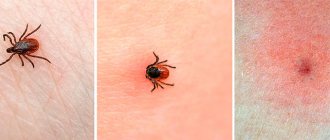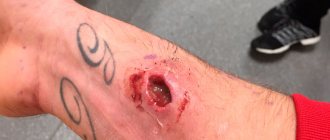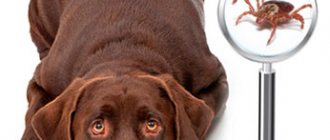Appearance Features
There are about 1,600 species of horseflies in nature. All of them are large in size - about 2 cm. The female is easy to distinguish by her large build, large iridescent eyes and the bridge between them.
The insect has an extremely complex oral apparatus. Powerful jaws, piercing, cutting, sucking components. Pierces the skin thanks to its fleshy, long proboscis.
The male's abdomen is pointed, the female's is rounded. Coloring in gray, brown dull tones. Large eyes are clearly visible, shimmering in the sun with all the colors of the rainbow.
Horsefly
Interesting facts from the life of horse flies
Horseflies are a type of midge (two-winged blood-sucking insects) that require human or animal blood to reproduce. Their numbers and species composition depend on climatic conditions and time of year. The favorite habitats of bloodsuckers are forests, banks of rivers and lakes, parks with dense vegetation, and pastures. They are often found in steppes and deserts, on the streets of large cities.
The active years of horse flies, which look like large flies, begin at the end of June. Insects love hot and windless weather. They are especially attracted by the smell of sweat and wet bodies.
This is interesting. Only female horse flies bite during breeding. Males feed exclusively on plant nectar.
Most often in Russia there are three types of bloodsuckers:
- Bullflies. The size of these dark brown flies ranges from 10 to 25 mm. They prefer forest edges and pastures, breed near rivers and swamps, laying eggs in the grass.
- Raincoats. Smaller insects (10–15 mm) are especially active before rain. Their wings have a marble pattern.
- Lacewings (pieds). Small (10–11 mm) flies are dark gray in color with a yellow belly. The wings of males are black, while those of females are transparent, with a dark pattern. They prefer the banks of rivers and lakes.
Causes of bites
Flies go through several stages of development. The female lays a huge number of eggs, within a week larvae emerge from them, and from there pupae. And only then a big fly flies out.
It’s not hard to guess why horseflies bite – everything has to do with nutrition and reproduction. Only females are dangerous. They need blood to lay eggs and maintain vital forces. Without this component, the female will not be able to give birth to new offspring.
The diet is dominated by fresh blood of livestock and wild animals. But if a person appears in the field of view, the horsefly will not miss the moment. Males feed exclusively on flower nectar and do not live long. After fertilization, the females soon die.
Interesting!
One female is capable of laying from 500 to 1000 eggs. The first stage larvae develop on the host body. They are cattle, forest dwellers. The worms feed on blood and after a while fall into the grass, onto the soil, and pupate there. After a few days, it transforms into a fly.
How can you protect yourself from horsefly bites?
So, to protect yourself from horse flies you need to:
- Wear light-colored clothing with long sleeves - insects' eyes are more adapted to bright and dark colors.
- Install mosquito nets on windows and balcony doors. You should also put a net over your stroller or rest tent.
- Use repellent aerosols: DEET, OFF, ARGUS Extreme, Reftamid. For safety reasons, children are recommended to use essential oils, which can be applied to clothing or skin, after first making sure that there is no allergic reaction. Esters of clove, lavender and eucalyptus have proven themselves well.
- Plant marigolds, geraniums or tomatoes in the garden - horse flies cannot stand their aroma. At home, you can put bunches of wormwood, lavender, peppermint or lemon balm on the window.
- Choose for a trip outside the city in the morning or evening, or on non-sunny days, since bloodsuckers are more active under the bright rays of the sun.
- Add chamomile to the fire - the smell of the plant will scare away annoying insects.
Before you go on vacation, you should find out what the likelihood of encountering these blood-sucking insects is and, if necessary, take protective equipment with you - repellents. If you still cannot avoid the bite, you should immediately treat the wound with an antiseptic, apply a cold compress and take an antihistamine. If the symptoms are mild, treatment can be carried out at home, but if the victim feels worse, it is necessary to contact a medical facility.
Quite often you hear: “I was bitten by a gadfly. What to do?". Firstly, I would like to immediately note that this is impossible. The fact is that almost all species of this insect do not have a piercing-cutting type of mouthparts. That is, even if they want to, they will not be able to bite through your skin. In principle, they don’t need this. Adult spiderworts (as gadflies are called in many areas) do not feed or bite!
They have enough of the substances that they accumulated while they were in the larval stage.
But what really stings both people and animals (including cattle) are horseflies. For what? To get blood, which, like the same mosquitoes, they need to reproduce.
Why then do you still hear from many people (and even doctors) about cases where gadflies were bitten? This is explained by the fact that people confuse these insects. As a result, horseflies and gadflies sometimes act as synonyms. That is, this is the name of all flies that overcome people, livestock, animals, etc.
When they bite
Flies are active during the daytime. They love sunshine and warm days. But among them there are representatives that parasitize in cloudy weather.
Insects react to movement and moisture. Attracts their wet, sweaty body. It is difficult to fight off horse flies after swimming in a pond, when your whole body glistens with droplets of water. They bite a wet body with beads of sweat even more intensely.
Horsefly bite What does a horsefly bite with - its proboscis and powerful jaws. The tenacious paws that dig into the skin add to the painful sensations. It bites anywhere on the human body. The neck and back are most often affected. In these areas, blood vessels are closer to the surface.
On a note!
The bite of a horsefly attracts other relatives to the victim. How horseflies bite is interesting not only to fauna lovers. In the process of piercing the vessels, the fly injects a substance that thins the blood and prevents it from clotting. After this, the wound bleeds for a long time, attracting hordes of new flies.
There are no parasites in urban areas, but if you go on a picnic or go to the country, there will be no end to the flies. To combat them, all kinds of traps and special insecticides are used, and the consequences of horsefly bites are treated in a special way.
Signs of parasitism on the skin
You can see what a horsefly bite looks like in the photo. Symptoms in humans are unpleasant, painful, and can occur with varying degrees of intensity. Main symptoms:
- instant redness of the skin;
- burning, severe itching;
- pain at the site of the bite;
- prolonged bleeding;
- puffiness, swelling;
- When pathogenic microorganisms enter the wound, suppuration develops.
The reaction to a bite in children is much stronger; red spots are clearly visible on sensitive skin. An allergy to a bite in sensitive people is manifested by large-scale redness of the skin, an additional rash, severe swelling, and unbearable itching.
After a horsefly bite, it is recommended to wash the wound and disinfect it, but in the field this can rarely be done. For people with strong immunity, the consequences of a horsefly bite are not so terrible, while people with a tendency to allergies have to undergo special treatment. The horsefly bite in the photo is shown below; you can assess the scale of the problem.
Insect bite on human body
Treatment
There is no specific therapy as such. If negative symptoms develop, measures are taken to eliminate them. It is extremely important that a qualified doctor does this, because self-medication can not only be useless, but also cause some harm.
As a rule, allergy sufferers, parents with small children and elderly people turn to doctors. Therapy is mainly applied locally, but systemic treatment may also be indicated.
Usually prescribed:
- antihistamines based on desloratadine, cetrin, suprastin, etc. orally or by injection if the clinical symptoms are serious,
- anti-inflammatory and specially designed ointments after bites of blood-sucking insects are applied to the inflamed skin (Rescuer, Psilobalzam and others),
- compresses with dimexide as an anti-inflammatory agent, but it cannot be used if there are allergic manifestations (in this case, applications with hydrocortisone are used).
Surgical intervention can be performed when ulcers, atheromas or deep boils form at the site of the bite. This development of events is likely when an infection enters the wound. The purpose of the operation is to remove purulent masses, sanitation of the wound and treatment with an antiseptic.
Severe consequences
An attack by a large fly is dangerous not only due to unpleasant sensations, skin damage, allergic reactions, but also terrible diseases. Insects are carriers of many diseases. Animals and humans can become infected with tularemia, filariasis, anthrax, and trypanosomiasis. You can get rid of horse flies using various means and traps.
If, in addition to the symptoms described above, there is a significant deterioration in health, body temperature rises, and the bite site swells, you must seek help from specialists, undergo an examination, and do not self-medicate.
Important!
In most cases, a horsefly bite goes away within a week, and the itching disappears within a few days. What to do if bitten by a horsefly, do not panic. Try to quickly treat the wound with an antiseptic, wipe with any alcohol tincture. Further actions depend on the condition of the skin and the body’s reaction.
Emergency therapy
Emergency care for a bite An infection gets into the open wound, which complicates the situation even more. Constant scratching is dangerous due to the addition of a secondary infection. In serious situations, local antibiotics must be used. But if everything is done correctly, you can avoid terrible complications.
- If you are bitten by a horsefly, you need to disinfect the wound as quickly as possible and stop the bleeding.
- In the field, the affected area is lubricated with saliva. But it is better to wipe the bite with any product containing alcohol.
- Another way to treat horsefly bites is to rinse the wound with clean running water. And even better with the addition of laundry soap. It is recommended to lather the sore area, leave for a few minutes, and rinse.
- How to treat swelling - apply a cold object to the affected area. At home, you can use ice and frozen meat. In the field - a bottle of drink, ice cream, cold water.
- If your hand is swollen or your temperature rises, this indicates an allergic reaction. In this case, a product containing antihistamine components is recommended. Fenistil gel, which can be found at any pharmacy on the way home, will help relieve swelling from a bite. If your leg is swollen, Zvezdochka balm, which contains more than 20 medicinal components, also helps.
- To prevent the bite from itching, the wound must be disinfected or a soda paste applied. Dilute baking soda with a small amount of water and apply it to the affected area for a few minutes. You can also anoint the horsefly bite with toothpaste containing mint ingredients.
- In the field, they will help cope with unpleasant symptoms and plant tumors. If a horsefly bite itches, you should smear the skin with the juice of dandelion, celandine, and plantain. The last component can be applied to the wound for a while.
- Lemon juice or a slice of citrus fruit will help disinfect the wound, prevent swelling, and stop itching.
- A solution of hydrogen peroxide or a concentrated preparation helps well.
How to treat a horsefly bite depends on the complexity of the situation. A terrible allergic reaction can be stopped by antihistamines that are taken orally and lubricate the skin.
For immediate relief of unpleasant symptoms, hormonal drugs are prescribed. Among them is Advantan, which can be used in children after 6 months. Not only the affected area can swell, but also the larynx with severe allergies. Then emergency medical assistance is required.
Remedies for horsefly bites:
- tincture of calendula, valerian, motherwort;
- potato gruel or juice;
- onion juice;
- garlic decoction;
- Valocordin;
- Corvalol;
- tea tree oil;
- aloe juice;
- propolis tincture.
If you treat the wound correctly and prevent infection, the consequences will go away as quickly as possible without complications.
First aid if bitten by a horsefly
How to react to gadfly bites?
- It is necessary to treat the affected area of the body as quickly as possible, rinsing it with clean water (or with soap). After all, it is worth remembering that these insects are carriers of infection (they do not disdain corpses and feces).
- You can then gently squeeze the liquid out from the bite site. This will help localize the spread of toxic saliva under the skin.
- After removing the dirt, you need to treat the wound:
- hydrogen peroxide solution;
- Chlorhexidine;
- Miramistin;
- potassium permanganate solution;
- Streptocide;
- propolis tincture;
- Furacilin;
- vodka.
- After treatment, it is better to cover the bite site with a band-aid.
- Regardless of whether the victim is allergic to insect bites, it is worth using some kind of antihistamine that will help reduce swelling and stop itching:
- Cetrin;
- Claritin;
- Loratadine;
- Suprastin;
- Parlazin et al.
- If severe pain is present, the use of analgesics will be very helpful. Recommended for use as an analgesic and antipyretic:
- Ibuprofen;
- Nimesulide;
- Paracetamol.
- If a horsefly bite does not cause a deterioration in the general condition of the victim, then it is enough to use local remedies for 2-3 days to speed up wound healing:
- Panthenol;
- Bepanten;
- Fenistil-gel;
- Rescuer.
If suppuration, nodes or lumps appear after a horsefly bite, you should urgently consult an infectious disease doctor
Particular attention should be paid to:
- heat;
- fever;
- nausea;
- vomit.
All this may indicate an infection of the body, which must be treated under the guidance of a doctor.
Treatment with traditional methods
Of course, the necessary medications and protective equipment may not always be at hand, so you need to know what you can use from available means to alleviate the condition of the victim.
- A lotion made from a bandage or any clean cloth soaked in:
- soda solution;
- Corvalbreaker;
- gruel of garlic or onion;
- raw potato juice (or grated);
- tomato puree;
- sour cream.
- Regular ice from the refrigerator, previously placed in a plastic bag, will help reduce swelling.
- The juice of an ordinary dandelion will help to disinfect the bite site, which is recommended to treat the affected area. After manipulations, you should wash your hands to prevent milky juice from getting into your eyes.
- A lotion of salt and soda will help clean the wound from insect saliva. To do this, dilute 1 teaspoon of each ingredient in 1 glass of warm boiled water. After the crystals are completely dissolved, a bandage is dipped into the liquid, soaking it completely. Then, the fabric is wrung out and applied to the bite site.
- A paste of fresh plantain leaves can relieve itching and stop bleeding. You can use dry plant materials, previously soaked in warm water. The wet mass is applied to the damaged area and secured with a bandage.
- A compress with a mixture of natural products will help relieve swelling and redness. To do this, you need to take 2 cloves of garlic, ½ medium-sized potato and ¼ onion. All this is ground on a grater or in a meat grinder. The resulting mixture is applied to the bite site, covered with film and secured with a bandage.











